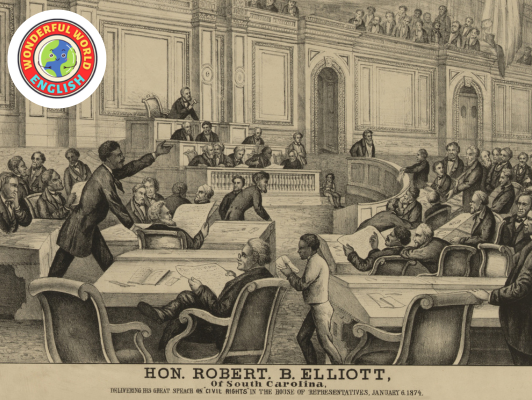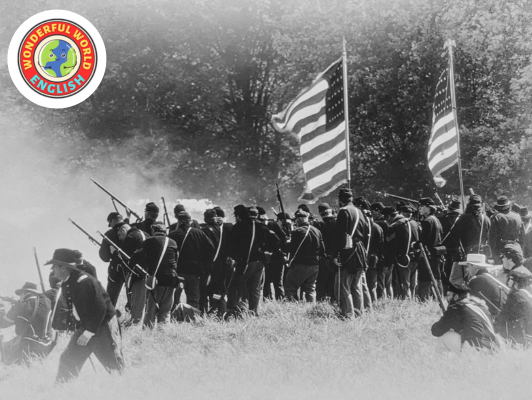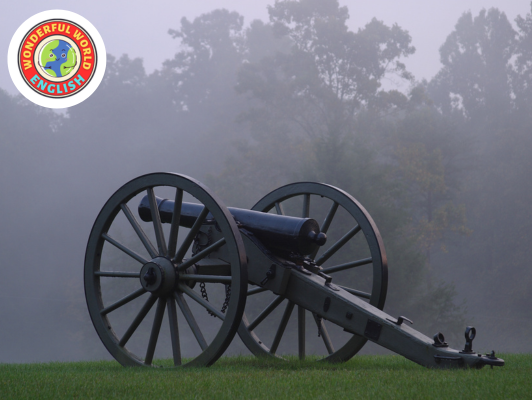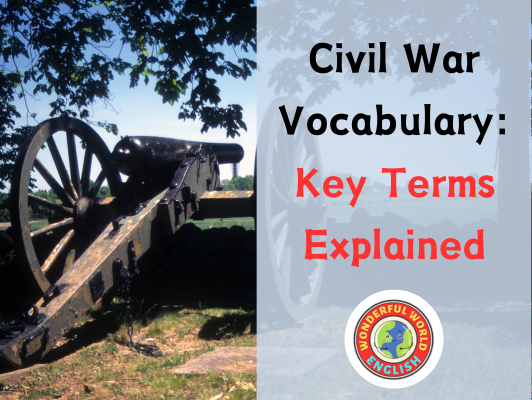Contents
Toggle
Meet David De’ Ath, founder, editor, and writer at Wonderful World English. With his extensive background as an English teacher, David provides valuable insights and practical tips on ESL for students and teachers alike.
The terminology used during the American Civil War is rich and varied, reflecting the complex military, social, and political landscape of the time.
Covering the period from 1861 to 1865, this conflict between the Northern states (the Union) and the Southern seceding states (the Confederacy) gave rise to a specific lexicon.
Understanding this vocabulary is essential for grasping the nuances of the historical narratives and analyses that explore one of the United States’ most transformative and tumultuous periods.
Gaining fluency in Civil War vocabulary allows individuals to better comprehend the historical documents, literature, and scholarship related to the era.
Terms such as “abolitionist,” “artillery,” and “blockade” provide insight into the strategies employed by both sides, the political ideologies that fueled the conflict, and the everyday experiences of those who lived through it.
From the war’s famous battles to the experiences of the common soldiers, each word paints a picture of the Civil War’s vast tapestry.
This vocabulary does more than merely chronicle a historical event; it serves as a key to unlocking the cultural and societal shifts that the conflict set in motion.
The war’s legacy is evident not only in the reunification of the United States but also in the fundamental changes to the nation’s fabric, including the end of slavery and the reconstruction of the South.
By exploring Civil War terminology, one steps into a pivotal era of American history.
Prelude to the Civil War
The period leading up to the American Civil War was marked by intense conflict over states’ rights and slavery.
The tension culminated with eleven southern states seceding from the Union, forming the Confederate States of America, which directly challenged the federal government’s authority.
Secession and the Confederate States
Secession is defined as the act of withdrawing from an organization, union, or especially a political entity.
The first state to secede from the United States was South Carolina in December 1860, soon followed by Mississippi, Florida, Alabama, Georgia, Louisiana, and Texas.
These states united to form the Confederate States of America, with Jefferson Davis being elected as its president.
The Confederacy was a collection of southern states that championed states’ rights and upheld the institution of slavery.
Key Figures of the Conflict
Several leading figures emerged during the American Civil War.
For the Union: Abraham Lincoln, the President of the United States, whose election partly triggered the succession, sought to preserve the Union.
Ulysses S. Grant became a prominent military leader for the Union forces, contributing to several decisive victories.
For the Confederates: Robert E. Lee emerged as an exceptional strategist and commander of the Confederate Army, while Jefferson Davis led the Confederate states as their President.
Their actions and decisions were pivotal in shaping the course of the war.
Slavery and Abolition Movements
The issue of slavery was central to the sectional discord that led to the Civil War.
Skirmishes over whether new states admitted to the Union would permit slavery were frequent.
The Abolition Movement, which sought to end the practice of slavery, gained momentum in the 19th century, with African Americans and their allies advocating for emancipation.
The turmoil over slavery eventually led to Lincoln’s Emancipation Proclamation, which declared the freedom of all slaves in Confederate-held territory.
This was a strategic move that added moral impetus to the Union’s cause and affected the lives of millions of African Americans.

Major Battles and Campaigns
The American Civil War featured numerous significant battles and strategic campaigns, which were primarily divided between the Eastern and Western Theaters of war.
These conflicts were pivotal in determining the course and eventual outcome of the war, with key figures like General Robert E. Lee and General Ulysses S. Grant taking center stage.
Eastern and Western Theaters
Eastern Theater:
- Virginia: Central to many crucial battles, Virginia saw extensive military action including the Battle of Gettysburg where General Lee’s Confederate army met the Union forces in a turning point for the Union. Glossary of Civil War Terms
Western Theater:
- Tennessee and Georgia: These states witnessed significant battles as the Union sought control over vital Confederate railroads and supply lines.
- Siege of Vicksburg: The Union army, under General Grant, conducted a successful siege which cut off the Confederate army in Mississippi and effectively split the Confederacy in half. Major Battles and Campaigns of the Civil War
Notable Conflicts and Turns of War
Battle of Gettysburg:
- Occurring from July 1 to July 3, 1863, this battle marked a crucial victory for the Union army and is often cited as the war’s turning point. Major Campaigns and battles of the Civil War
Siege of Vicksburg:
- Stretching from May 18 to July 4, 1863, the siege resulted in a significant Union victory and was pivotal in gaining control of the Mississippi River.
Throughout the war, both the Union army and the Confederate army faced off in numerous other battles across various states, impacting the momentum and morale of both sides.
If you’re interested in the Civil war, you may also be fascinated by the Napoleonic era, namely the man himself, Napoleon!
For some insights into the French emperor’s English proficiency levels, check out the link below!
Related: Did Napoleon Speak English? – Everything You Need to Know

Military Strategies and Technology
During the American Civil War, military strategies and technology evolved significantly, seeing advancements in weaponry and the strategic use of naval power.
These components played crucial roles in the outcomes of various conflicts between Union and Confederate forces.
Weapons and Warfare
The Civil War era was marked by the transition from traditional smoothbore muskets to more accurate rifled muskets and the introduction of repeating firearms.
The Union army’s use of rifled artillery allowed for greater range and precision, altering how battles were fought.
This change meant that infantry tactics had to be adapted; soldiers could no longer rely on massed formations and had to consider new forms of cover and maneuverability on the battlefield.
The concept of “total war”—targeting not just the opposing military but also the economic and civilian infrastructure supporting them—was employed by Union generals like Sherman in his infamous “March to the Sea.”
This strategy aimed to diminish the Confederate’s capacity to wage war and undermine the civilian morale.
Naval Engagements and Blockades
Union forces implemented the Anaconda Plan, which was a naval blockade strategy intended to suffocate the Confederacy economically by cutting off access to international trade routes.
One prominent feature of this plan was the blockade of Southern ports, which had a crippling effect on the Confederate economy.
Technological advancements were not limited to land warfare.
The age of wooden ships gave way to “ironclads”—warships clad in iron armor—which dramatically changed naval combat.
The famous clash between the CSS Virginia (a converted ironclad formerly known as the Merrimack) and the USS Monitor exemplified the shift to ironclad vessels and marked a new era in naval warfare.

The Civil War’s Aftermath
The end of the Civil War marked the beginning of a complex period of rebuilding and reconciliation in America, known as the Reconstruction Era, which had profound long-term consequences on civil rights and the nation’s understanding of freedom.
Reconstruction Era
After the Civil War, the United States entered the Reconstruction Era, a pivotal time from 1865 to 1877 aimed at restoring the Confederate states to the Union and defining the new rights of the freed African Americans.
Notably, the American Battlefield Trust references the term “Armory,” epitomizing the shift from conflict to rebuilding military and societal structures.
Key legislation during this era included the 13th, 14th, and 15th Amendments, which abolished slavery, granted citizenship, and protected voting rights for African Americans, respectively.
Legislation and key policies of the Reconstruction Era:
- 13th Amendment: Abolition of slavery
- 14th Amendment: Citizenship for all born in the U.S.
- 15th Amendment: Voting rights irrespective of race
Long-Term Consequences
The consequences of the Civil War extended far beyond the immediate post-war years, deeply influencing America’s social fabric and legal framework.
Emancipation paved the way for the civil rights movement, which would emerge as a powerful force for change.
Despite the formal end of slavery, African Americans faced systemic challenges, including segregation and disenfranchisement.
The complexities of this era set the stage for ongoing struggles for equality and freedom, emphasizing the notion that battles for civil rights in the United States would require enduring vigilance and advocacy.
Key long-term consequences:
- Ongoing civil rights struggles
- The concept of freedom undergoes redefinition
- African Americans face new forms of inequality
The aftermath of the Civil War was a defining moment for America, as the nation grappled with the implications of emancipation and the broader definition of union and freedom.
The legacy of the Civil War and Reconstruction continues to influence the fabric of the United States and its approach to civil rights.
| Term | Definition | Category |
|---|---|---|
| Abolitionist | A person who advocated or supported the abolition of slavery. | Social |
| Artillery | Large caliber guns used in warfare on land. | Military |
| Blockade | The action or an act of sealing off a place to prevent goods or people from entering or leaving. | Military |
| Secession | The action of withdrawing formally from membership of a federation or body, especially a political state. | Political |
| Emancipation Proclamation | An executive order issued by President Lincoln in 1863 that declared the freedom of all slaves in Confederate-held territory. | Political |
| Ironclads | Warships clad in iron armor, representing a significant advancement in naval technology. | Military |
| Reconstruction | The period after the Civil War from 1865 to 1877, focused on the reintegration of Southern states into the Union and defining new rights. | Political |
| Union | The northern states that remained loyal to the Federal government during the Civil War. | Political |
| Confederacy | The collective name for the southern states that seceded from the United States and fought against the Union. | Political |
| Anaconda Plan | A Union strategy during the Civil War aiming to blockade Confederate ports and capture the Mississippi River to isolate the South. | Military |
| 13th Amendment | An amendment to the US Constitution that abolished slavery and involuntary servitude, except as punishment for a crime. | Legal |
| 14th Amendment | An amendment that granted citizenship to all persons born or naturalized in the United States, including former slaves. | Legal |
| 15th Amendment | An amendment that prohibits the government from denying a citizen the right to vote based on that citizen’s race, color, or past servitude. | Legal |
Conclusion
The Civil War, a defining chapter in American history, not only shaped the nation’s course but also gave rise to a distinct lexicon that reflects its complex military, social, and political facets.
This rich terminology serves as a bridge to understanding the era’s profound impacts and the narratives that define it.
By delving into the vocabulary of the Civil War, we unlock a deeper comprehension of the conflict’s dynamics, the ideologies at play, and the human experiences within it.
The words and phrases born from this period—ranging from military strategies to the names of key figures and pivotal events—offer invaluable insights into the strategies, ideologies, and daily realities of the time.
This lexicon does more than catalog events; it illuminates the cultural and societal shifts triggered by the war, including the end of slavery and the arduous journey toward national reunification and reconstruction.
Engaging with Civil War vocabulary is not merely an academic exercise but a portal to appreciating the transformative power of this historical epoch.
It enables us to grasp the nuanced narratives and analyses that dissect the war’s lasting legacy on American society, including its role in shaping the nation’s fabric and the ongoing quest for equality and freedom.
The vocabulary of the Civil War is a key to unlocking the era’s significance, offering a lens through which we can explore and understand the monumental shifts it set in motion.
Through these terms, we connect with the past, gaining insights into the conflict that reshaped the United States, forging a new path for the nation and its people.
We hope you find value in this information; you can contact us if you require any support.
Have a wonderful day!
Image Attribution: All images licensed via canva.com





